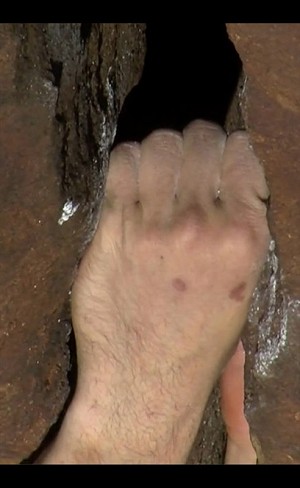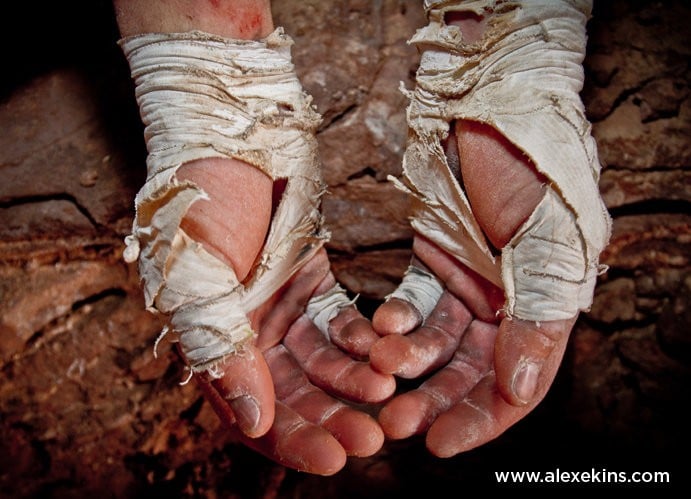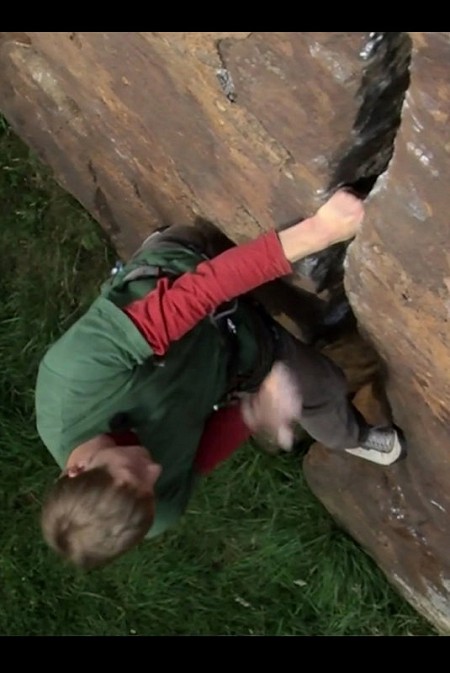Part 3 - Fist Cracks
Fist Jamming

One of the things that you'll notice when you first attempt to fist jam, is that the range of expansion that you have in your fist jam is very small. This means that often the jams will not fit your fist size very well and as a result will feel extremely tenuous. There are however, a few tricks that can see you round this problem and hopefully have you heading upwards towards glory.
Crack routes of this size are spread entirely through the grades, although you'll find that completely pure fist cracks tend to start at about HVS or so. One thing, to always bear in mind is the subject of taping up for this size. I'd recommend that you put some level of protection on your hands, even if it's only a token amount. Technique is learnt so much faster when you're not in pain.
Techniques and tips
The most important part of your fist jam, is not the fist, but (like the hand jam) the action of the thumb. When you form a fist, you'll notice that you're able to freely move your thumb around, even when your fist is tightly clenched. This means that you're able to use the thumb as a spacer, to fill any gap between your fist and the side of the crack.
If you find a perfectly tight crack, then you will need no thumb spacer at all (see at the start of the video). However, should the crack be a little too wide, then you can lay your thumb down the outside of your fist (see the "teacup jam in the video) which will give you extra purchase. I should point out that fist jams rarely feel completely bomber in parallel cracks, so don't expect them to feel quite as good as a hand jam!
Another way in which you can "force" a fist jam to feel slightly more secure is to bring the centre of your balance to one side of the crack – almost as if you were about to start a layback. That way, as well as jamming your fist in the crack, you're also torquing it in sideways for extra purchase. I've often used this in moments of desperation, or to place gear.
Feet
Fortunately, the footwork for fist-sized cracks is actually pretty straight forward. Mostly, you will find that the width of your fist will match the width of your foot and so, you can simply kick your foot forwards into the crack and it will fit snugly – simple as that! If you find that this doesn't work, then apply the same method as you did for hand jamming cracks, where you turn your foot sideways before keying it in by twisting.
I'm often asked if you can get your foot stuck in cracks. Mostly the answer is that it's very unlikely, but if I'm honest, the one situation in which you might find yourself unpleasantly wedged is in a fist crack. My solution has always been twist my knee outwards (so that you're turning your foot on its side) whilst taking as much weight off it as possible. Most people panic in this situation, so remember a calm head will always pay dividends.
A few more hints for Fist Jams
They say in Yosemite, that you need to climb a mile of any particular crack size to master it. Finding that length of fist crack in the UK is extremely hard, so try and throw some laps on any fist cracks that you come across – they're a bit of a rare breed!
Skin loss on fist jamming can often be worst across the thumb, so try to tape this area really well. I start nearest the nail and head back towards the back of my hand, so the tape is less likely to come undone.
Try using a combination of upwards-facing and downwards-facing fist jams (see video) when first attempting to learn this technique. It means you don't have to cross hands and also allows you to make longer reaches between the jams.
If you attempt a long fist jamming route, don't forget to tape your little finger as well as it's common to get a flapper on the joint of this digit after long pitches.
Don't give up – this technique is hard won!
Classic fist cracks /routes with crucial fist crack sections



